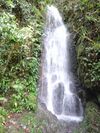Earth:Water quality
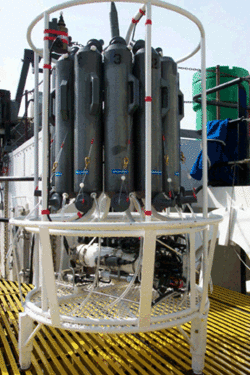
Water quality refers to the chemical, physical, and biological characteristics of water based on the standards of its usage.[1][2] It is most frequently used by reference to a set of standards against which compliance, generally achieved through treatment of the water, can be assessed. The most common standards used to monitor and assess water quality convey the health of ecosystems, safety of human contact, extent of water pollution and condition of drinking water. Water quality has a significant impact on water supply and oftentimes determines supply options.[3]
Impacts on public health
Over time, there has been increasing recognition of the importance of drinking water quality and its impact on public health. This has led to increasing protection and management of water quality.[4]
The understanding of the links between water quality and health continues to grow and highlight new potential health crises: from the chronic impacts of infectious diseases on child development through stunting to new evidence on the harms from known contaminants, such as manganese with growing evidence of neurotoxicity in children.[4] In addition, there are many emerging water quality issues—such as microplastics, perfluorinated compounds, and antimicrobial resistance.[4]
Categories
The parameters for water quality are determined by the intended use. Work in the area of water quality tends to be focused on water that is treated for potability, industrial/domestic use, or restoration (of an environment/ecosystem, generally for health of human/aquatic life).[5]
Human consumption
Contaminants that may be in untreated water include microorganisms such as viruses, protozoa and bacteria; inorganic contaminants such as salts and metals; organic chemical contaminants from industrial processes and petroleum use; pesticides and herbicides; and radioactive contaminants. Water quality depends on the local geology and ecosystem, as well as human uses such as sewage dispersion, industrial pollution, use of water bodies as a heat sink, and overuse (which may lower the level of the water).[citation needed]
The United States Environmental Protection Agency[6] (EPA) limits the amounts of certain contaminants in tap water provided by US public water systems. The Safe Drinking Water Act authorizes EPA to issue two types of standards:
- primary standards regulate substances that potentially affect human health;[7][8]
- secondary standards prescribe aesthetic qualities, those that affect taste, odor, or appearance.[9]
The U.S. Food and Drug Administration (FDA) regulations establish limits for contaminants in bottled water. [10] Drinking water, including bottled water, may reasonably be expected to contain at least small amounts of some contaminants. The presence of these contaminants does not necessarily indicate that the water poses a health risk.
In urbanized areas around the world, water purification technology is used in municipal water systems to remove contaminants from the source water (surface water or groundwater) before it is distributed to homes, businesses, schools and other recipients. Water drawn directly from a stream, lake, or aquifer and that has no treatment will be of uncertain quality in terms of potability.[3]
The burden of polluted drinking water disproportionally effects under-represented and vulnerable populations.[11] Communities that lack these clean drinking-water services are at risk of contracting water-borne and pollution-related illnesses like Cholera, diarrhea, dysentery, hepatitis A, typhoid, and polio.[12] These communities are often in low-income areas, where human wastewater is discharged into a nearby drainage channel or surface water drain without sufficient treatment, or is used in agricultural irrigation.
Industrial and domestic use
Dissolved ions may affect the suitability of water for a range of industrial and domestic purposes. The most familiar of these is probably the presence of calcium (Ca2+) and magnesium (Mg2+) that interfere with the cleaning action of soap, and can form hard sulfate and soft carbonate deposits in water heaters or boilers.[13] Hard water may be softened to remove these ions. The softening process often substitutes sodium cations.[14] For certain populations, hard water may be preferable to soft water because health problems have been associated with calcium deficiencies and with excess sodium.[15] The necessity for additional calcium and magnesium in water depends on the population in question because people generally satisfy their recommended amounts through food.[3]:99, 115, 377
Environmental water quality
Environmental water quality, also called ambient water quality, relates to water bodies such as lakes, rivers, and oceans.[16] Water quality standards for surface waters vary significantly due to different environmental conditions, ecosystems, and intended human uses. Toxic substances and high populations of certain microorganisms can present a health hazard[17] for non-drinking purposes such as irrigation, swimming, fishing, rafting, boating, and industrial uses. These conditions may also affect wildlife, which use the water for drinking or as a habitat. According to the EPA, water quality laws generally specify protection of fisheries and recreational use and require, as a minimum, retention of current quality standards.[18] In some locations, desired water quality conditions include high dissolved oxygen concentrations, low chlorophyll-a concentrations, and high water clarity.[19]
There is some desire among the public to return water bodies to pristine, or pre-industrial conditions.[20] Most current environmental laws focus on the designation of particular uses of a water body. In some countries these designations allow for some water contamination as long as the particular type of contamination is not harmful to the designated uses. Given the landscape changes (e.g., land development, urbanization, clearcutting in forested areas) in the watersheds of many freshwater bodies, returning to pristine conditions would be a significant challenge. In these cases, environmental scientists focus on achieving goals for maintaining healthy ecosystems and may concentrate on the protection of populations of endangered species and protecting human health.
Sampling and measurement
Sample collection
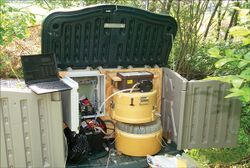
<section begin=sampling /> The complexity of water quality as a subject is reflected in the many types of measurements of water quality indicators. Some measurements of water quality are most accurately made on-site, because water exists in equilibrium with its surroundings. Measurements commonly made on-site and in direct contact with the water source in question include temperature, pH, dissolved oxygen, conductivity, oxygen reduction potential (ORP), turbidity, and Secchi disk depth.
Sampling of water for physical or chemical testing can be done by several methods, depending on the accuracy needed and the characteristics of the contaminant. Sampling methods include for example simple random sampling, stratified sampling, systematic and grid sampling, adaptive cluster sampling, grab samples, semi-continuous monitoring and continuous, passive sampling, remote surveillance, remote sensing, and biomonitoring. The use of passive samplers greatly reduces the cost and the need of infrastructure on the sampling location.
Many contamination events are sharply restricted in time, most commonly in association with rain events. For this reason "grab" samples are often inadequate for fully quantifying contaminant levels.[21] Scientists gathering this type of data often employ auto-sampler devices that pump increments of water at either time or discharge intervals.<section end=sampling />
More complex measurements are often made in a laboratory requiring a water sample to be collected, preserved, transported, and analyzed at another location.
Issues
The process of water sampling introduces two significant problems:
- The first problem is the extent to which the sample may be representative of the water source of interest. Water sources vary with time and with location. The measurement of interest may vary seasonally or from day to night or in response to some activity of man or natural populations of aquatic plants and animals.[22] The measurement of interest may vary with distances from the water boundary with overlying atmosphere and underlying or confining soil. The sampler must determine if a single time and location meets the needs of the investigation, or if the water use of interest can be satisfactorily assessed by averaged values of sampling over time and location, or if critical maxima and minima require individual measurements over a range of times, locations or events. The sample collection procedure must assure correct weighting of individual sampling times and locations where averaging is appropriate.[23]:39–40 Where critical maximum or minimum values exist, statistical methods must be applied to observed variation to determine an adequate number of samples to assess the probability of exceeding those critical values.[24]
- The second problem occurs as the sample is removed from the water source and begins to establish chemical equilibrium with its new surroundings – the sample container. Sample containers must be made of materials with minimal reactivity with substances to be measured; pre-cleaning of sample containers is important. The water sample may dissolve part of the sample container and any residue on that container, and chemicals dissolved in the water sample may sorb onto the sample container and remain there when the water is poured out for analysis.[23]:4 Similar physical and chemical interactions may take place with any pumps, piping, or intermediate devices used to transfer the water sample into the sample container. Water collected from depths below the surface will normally be held at the reduced pressure of the atmosphere; so gas dissolved in the water will collect at the top of the container. Atmospheric gas above the water may also dissolve into the water sample. Other chemical reaction equilibria may change if the water sample changes temperature. Finely divided solid particles formerly suspended by water turbulence may settle to the bottom of the sample container, or a solid phase may form from biological growth or chemical precipitation. Microorganisms within the water sample may biochemically alter concentrations of oxygen, carbon dioxide, and organic compounds. Changing carbon dioxide concentrations may alter pH and change solubility of chemicals of interest. These problems are of special concern during measurement of chemicals assumed to be significant at very low concentrations.[22]
Sample preservation may partially resolve the second problem. A common procedure is keeping samples cold to slow the rate of chemical reactions and phase change, and analyzing the sample as soon as possible; but this merely minimizes the changes rather than preventing them.[23]:43–45 A useful procedure for determining influence of sample containers during delay between sample collection and analysis involves preparation for two artificial samples in advance of the sampling event. One sample container is filled with water known from previous analysis to contain no detectable amount of the chemical of interest. This sample, called a "blank", is opened for exposure to the atmosphere when the sample of interest is collected, then resealed and transported to the laboratory with the sample for analysis to determine if sample collection or holding procedures introduced any measurable amount of the chemical of interest. The second artificial sample is collected with the sample of interest, but then "spiked" with a measured additional amount of the chemical of interest at the time of collection. The blank (negative control) and spiked sample (positive control) are carried with the sample of interest and analyzed by the same methods at the same times to determine any changes indicating gains or losses during the elapsed time between collection and analysis.[25]
Testing in response to natural disasters and other emergencies
After events such as earthquakes and tsunamis, there is an immediate response by the aid agencies as relief operations get underway to try and restore basic infrastructure and provide the basic fundamental items that are necessary for survival and subsequent recovery.[26] The threat of disease increases hugely due to the large numbers of people living close together, often in squalid conditions, and without proper sanitation.[27]
After a natural disaster, as far as water quality testing is concerned, there are widespread views on the best course of action to take and a variety of methods can be employed. The key basic water quality parameters that need to be addressed in an emergency are bacteriological indicators of fecal contamination, free chlorine residual, pH, turbidity and possibly conductivity/total dissolved solids. There are many decontamination methods.[28][29]
After major natural disasters, a considerable length of time might pass before water quality returns to pre-disaster levels. For example, following the 2004 Indian Ocean tsunami the Colombo-based International Water Management Institute (IWMI) monitored the effects of saltwater and concluded that the wells recovered to pre-tsunami drinking water quality one and a half years after the event.[30] IWMI developed protocols for cleaning wells contaminated by saltwater; these were subsequently officially endorsed by the World Health Organization as part of its series of Emergency Guidelines.[31]
Chemical analysis
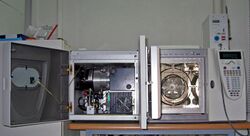
mass spectrometer measures pesticides and other organic pollutants
The simplest methods of chemical analysis are those measuring chemical elements without respect to their form. Elemental analysis for oxygen, as an example, would indicate a concentration of 890 g/L (grams per litre) of water sample because oxygen (O) has 89% mass of the water molecule (H2O). The method selected to measure dissolved oxygen should differentiate between diatomic oxygen and oxygen combined with other elements. The comparative simplicity of elemental analysis has produced a large amount of sample data and water quality criteria for elements sometimes identified as heavy metals. Water analysis for heavy metals must consider soil particles suspended in the water sample. These suspended soil particles may contain measurable amounts of metal. Although the particles are not dissolved in the water, they may be consumed by people drinking the water. Adding acid to a water sample to prevent loss of dissolved metals onto the sample container may dissolve more metals from suspended soil particles. Filtration of soil particles from the water sample before acid addition, however, may cause loss of dissolved metals onto the filter.[32] The complexities of differentiating similar organic molecules are even more challenging.
Making these complex measurements can be expensive. Because direct measurements of water quality can be expensive, ongoing monitoring programs are typically conducted and results released by government agencies. However, there are local volunteer programs and resources available for some general assessment.[33] Tools available to the general public include on-site test kits, commonly used for home fish tanks, and biological assessment procedures.
Biosensors
Biosensors have the potential for "high sensitivity, selectivity, reliability, simplicity, low-cost and real-time response".[34] For instance, bionanotechnologists reported the development of ROSALIND 2.0, that can detect levels of diverse water pollutants.[35][36]
Real-time monitoring
Although water quality is usually sampled and analyzed at laboratories, since the late 20th century there has been increasing public interest in the quality of drinking water provided by municipal systems. Many water utilities have developed systems to collect real-time data about source water quality. In the early 21st century, a variety of sensors and remote monitoring systems have been deployed for measuring water pH, turbidity, dissolved oxygen and other parameters.[37] Some remote sensing systems have also been developed for monitoring ambient water quality in riverine, estuarine and coastal water bodies.[38][39]
Subnero, a Singapore-based underwater wireless networked communication company, developed the Subnero Water Assessment Network (SWAN) to monitor water quality while enabling real-time and remote data visualization on a web browser[40].[41]
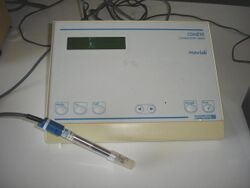
The following is a list of indicators often measured by situational category:
- Alkalinity
- Color of water
- pH
- Taste and odor (geosmin, 2-Methylisoborneol (MIB), etc.)
- Dissolved metals and salts (sodium, chloride, potassium, calcium, manganese, magnesium)
- Microorganisms such as fecal coliform bacteria (Escherichia coli), Cryptosporidium, and Giardia lamblia; see Bacteriological water analysis
- Dissolved metals and metalloids (lead, mercury, arsenic, etc.)
- Dissolved organics: colored dissolved organic matter (CDOM), dissolved organic carbon (DOC)
- Radon
- Heavy metals
- Pharmaceuticals
- Hormone analogs
Environmental indicators
Physical indicators
|
|
Chemical indicators
|
|
Biological indicators
|
|
|
Biological monitoring metrics have been developed in many places, and one widely used family of measurements for freshwater is the presence and abundance of members of the insect orders Ephemeroptera, Plecoptera and Trichoptera (EPT) (of benthic macroinvertebrates whose common names are, respectively, mayfly, stonefly and caddisfly). EPT indexes will naturally vary from region to region, but generally, within a region, the greater the number of taxa from these orders, the better the water quality. Organisations in the United States, such as EPA. offer guidance on developing a monitoring program and identifying members of these and other aquatic insect orders. Many US wastewater dischargers (e.g., factories, power plants, refineries, mines, municipal sewage treatment plants) are required to conduct periodic whole effluent toxicity (WET) tests.[42][43]
Individuals interested in monitoring water quality who cannot afford or manage lab scale analysis can also use biological indicators to get a general reading of water quality. One example is the IOWATER volunteer water monitoring program of Iowa, which includes an EPT indicator key.[44]
Bivalve molluscs are largely used as bioindicators to monitor the health of aquatic environments in both fresh water and the marine environments. Their population status or structure, physiology, behaviour or the level of contamination with elements or compounds can indicate the state of contamination status of the ecosystem. They are particularly useful since they are sessile so that they are representative of the environment where they are sampled or placed. A typical project is the U.S. Mussel Watch Programme,[45] but today they are used worldwide.
The Southern African Scoring System (SASS) method is a biological water quality monitoring system based on the presence of benthic macroinvertebrates (EPT). The SASS aquatic biomonitoring tool has been refined over the past 30 years and is now on the fifth version (SASS5) which has been specifically modified in accordance with international standards, namely the ISO/IEC 17025 protocol.[46] The SASS5 method is used by the South African Department of Water Affairs as a standard method for River Health Assessment, which feeds the national River Health Programme and the national Rivers Database.
Climate change impacts
Standards and reports
In the setting of standards, agencies make political and technical/scientific decisions based on how the water will be used.[47] In the case of natural water bodies, agencies also make some reasonable estimate of pristine conditions. Natural water bodies will vary in response to a region's environmental conditions, whereby water composition is influenced by the surrounding geological features, sediments, and rock types, topography, hydrology, and climate.[48] Environmental scientists and aqueous geochemists work to interpret the parameters and environmental conditions that impact the water quality of a region, which in turn helps to identify the sources and fates of contaminants. Environmental lawyers and policymakers work to define legislation with the intention that water is maintained at an appropriate quality for its identified use.
Another general perception of water quality is that of a simple property that tells whether water is polluted or not. In fact, water quality is a complex subject, in part because water is a complex medium intrinsically tied to the ecology, geology, and anthropogenic activities of a region. Industrial and commercial activities (e.g. manufacturing, mining, construction, transport) are a major cause of water pollution as are runoff from agricultural areas, urban runoff and discharge of treated and untreated sewage.[citation needed]
International
- The World Health Organization (WHO) published updated guidelines for drinking-water quality (GDWQ) in 2017.[3]
- The International Organization for Standardization (ISO) published [when?] regulation of water quality in the section of ICS 13.060,[49] ranging from water sampling, drinking water, industrial class water, sewage, and examination of water for chemical, physical or biological properties. ICS 91.140.60 covers the standards of water supply systems.[50]
National specifications for ambient water and drinking water
European Union
The water policy of the European Union is primarily codified in three directives:
- Directive on Urban Waste Water Treatment (91/271/EEC) of 21 May 1991 concerning discharges of municipal and some industrial wastewaters;
- The Drinking Water Directive (98/83/EC) of 3 November 1998 concerning potable water quality;
- Water Framework Directive (2000/60/EC) of 23 October 2000 concerning water resources management.
India
- Indian Council of Medical Research (ICMR) Standards for Drinking Water.
South Africa
Water quality guidelines for South Africa are grouped according to potential user types (e.g. domestic, industrial) in the 1996 Water Quality Guidelines.[51] Drinking water quality is subject to the South African National Standard (SANS) 241 Drinking Water Specification.[52]
United Kingdom
In England and Wales acceptable levels for drinking water supply are listed in the "Water Supply (Water Quality) Regulations 2000."[53]
United States
Drinking water standards, which are applicable to public water systems, are issued by EPA under the Safe Drinking Water Act.[8]
See also
- Aquatic toxicology
- Permanganate index
- Stiff diagram, a graphical representation of chemical analyses
- Water clarity
- Water quality modelling
- Water testing
- Water treatment
References
- ↑ Cordy, Gail E. (March 2001). "A Primer on Water Quality". Reston, VA: U.S. Geological Survey (USGS). https://pubs.usgs.gov/fs/fs-027-01/.
- ↑ Johnson, D. L.; Ambrose, S. H.; Bassett, T. J.; Bowen, M. L.; Crummey, D. E.; Isaacson, J. S.; Johnson, D. N.; Lamb, P. et al. (1997). "Meanings of Environmental Terms". Journal of Environmental Quality 26 (3): 581–589. doi:10.2134/jeq1997.00472425002600030002x.
- ↑ 3.0 3.1 3.2 3.3 Guidelines for Drinking-water Quality: Fourth edition incorporating the first addendum (Report). Geneva: World Health Organization (WHO). 2017. ISBN 9789241549950. https://apps.who.int/iris/handle/10665/254637.
- ↑ 4.0 4.1 4.2 Khan, Nameerah; Charles, Katrina J. (2023). "When Water Quality Crises Drive Change: A Comparative Analysis of the Policy Processes Behind Major Water Contamination Events" (in en). Exposure and Health 15 (3): 519–537. doi:10.1007/s12403-022-00505-0. ISSN 2451-9766. PMID 36196073. PMC 9522453. https://link.springer.com/10.1007/s12403-022-00505-0.
 Text was copied from this source, which is available under a Creative Commons Attribution 4.0 International License
Text was copied from this source, which is available under a Creative Commons Attribution 4.0 International License
- ↑ "Other Uses and Types of Water". Atlanta, GA: US Centers for Disease Control and Prevention (CDC). 2021-08-10. https://www.cdc.gov/healthywater/other/index.html.
- ↑ "What is water quality? Eight key characteristics" (in en-US). https://waterrangers.ca/what-is-water-quality/.
- ↑ U.S. Environmental Protection Agency (EPA), Washington, D.C. "National Primary Drinking Water Regulations." Code of Federal Regulations, 40 C.F.R. 141.
- ↑ 8.0 8.1 "Drinking Water Regulations". EPA. 2022-09-20. https://www.epa.gov/dwreginfo/drinking-water-regulations.
- ↑ "Secondary Drinking Water Standards: Guidance for Nuisance Chemicals". EPA. 2022-02-17. https://www.epa.gov/dwstandardsregulations/secondary-drinking-water-standards-guidance-nuisance-chemicals.
- ↑ "FDA Regulates the Safety of Bottled Water Beverages Including Flavored Water and Nutrient-Added Water Beverages". Silver Spring, MD: U.S. Food and Drug Administration. 2018-09-22. https://www.fda.gov/Food/FoodborneIllnessContaminants/BuyStoreServeSafeFood/ucm046894.htm.
- ↑ Katner, A. L.; Brown, K; Pieper, K.; Edwards, M; Lambrinidou, Y; Subra, W. (2018). "America’s Path to Drinking Water Infrastructure Inequality and Environmental Injustice: The Case of Flint, Michigan". The Palgrave Handbook of Sustainability. London: Palgrave Macmillan. pp. 79–97. doi:10.1007/978-3-319-71389-2_5. ISBN 978-3-319-71388-5.
- ↑ "Drinking-water". WHO. 2022-03-21. https://www.who.int/en/news-room/fact-sheets/detail/drinking-water.
- ↑ Babbitt, Harold E.; Doland, James J. (1949). Water Supply Engineering. New York: McGraw-Hill. p. 388.
- ↑ Linsley, Ray K; Franzini, Joseph B. (1972). Water-Resources Engineering. McGraw-Hill. pp. 454–456. ISBN 0-07-037959-9.
- ↑ WHO (2004). "Consensus of the Meeting: Nutrient minerals in drinking-water and the potential health consequences of long-term consumption of demineralized and remineralized and altered mineral content drinking-waters." Rolling Revision of the WHO Guidelines for Drinking-Water Quality (draft). From 11–13 November 2003 meeting in Rome, Italy at the WHO European Centre for Environment and Health.
- ↑ "Supplemental Module: Human Health Ambient Water Quality Criteria". EPA. 2022-06-28. https://www.epa.gov/wqs-tech/supplemental-module-human-health-ambient-water-quality-criteria.
- ↑ Adlish, John I.; Costa, Davide; Mainardi, Enrico; Neuhold, Piero; Surrente, Riccardo; Tagliapietra, Luca J. (2020-10-31). "Polyethylene Identification in Ocean Water Samples by Means of 50 keV Energy Electron Beam". Instruments 4 (4): 32. doi:10.3390/instruments4040032. "Plastic is the most common type of marine debris found in oceans, and it is the most widespread problem affecting the marine environment. It also threatens ocean health, food safety and quality, human health, and coastal tourism, and it contributes to climate change".
- ↑ Water Quality Standards Handbook Chapter 3: Water Quality Criteria. EPA. 2017. EPA 823-B-17-001. https://www.epa.gov/sites/production/files/2014-10/documents/handbook-chapter3.pdf.
- ↑ Tango, Peter J.; Batiuk, Richard A. (2013-09-04). "Deriving Chesapeake Bay Water Quality Standards". JAWRA Journal of the American Water Resources Association (Wiley) 49 (5): 1007–1024. doi:10.1111/jawr.12108. ISSN 1093-474X. Bibcode: 2013JAWRA..49.1007T.
- ↑ "Watershed Restoration Program". Washington, DC: US Forest Service. https://www.fs.usda.gov/restoration/Watershed_Restoration/.
- ↑ "Sampling - KFUPM School , nature is us - Forums - Tunza Eco Generation". https://tunza.eco-generation.org/resourcesView.jsp?boardID=forum1384875145&viewID=7935&searchType=&searchName=&pageNumber=55.
- ↑ 22.0 22.1 Goldman, Charles R.; Horne, Alexander J. (1983). "6. Chemicals and Growth Factors". Limnology. McGraw-Hill. ISBN 0-07-023651-8.
- ↑ 23.0 23.1 23.2 Franson, Mary Ann (1975). Standard Methods for the Examination of Water and Wastewater 14th ed. Washington, DC: American Public Health Association, American Water Works Association & Water Pollution Control Federation. ISBN:0-87553-078-8
- ↑ Handbook for Monitoring Industrial Wastewater (Report). EPA. August 1973. EPA 625/6-73/002.
- ↑ "Definitions of Quality-Assurance Data". Denver, CO: USGS, Quality Systems Branch. 2009-08-28. https://bqs.usgs.gov/memos/secondary_body.php?Page=aggregated.coding.html.
- ↑ Natural Disasters and Severe Weather (2014-08-13). "Tsunamis: Water Quality". CDC. https://www.cdc.gov/disasters/tsunamis/waterquality.html.
- ↑ Furusawa, Takuro; Maki, Norio; Suzuki, Shingo (2008-01-01). "Bacterial contamination of drinking water and nutritional quality of diet in the areas of the western Solomon Islands devastated by the April 2, 2007 earthquake⁄tsunami". Tropical Medicine and Health 36 (2): 65–74. doi:10.2149/tmh.2007-63. https://www.jstage.jst.go.jp/article/tmh/36/2/36_2007-63/_article.
- ↑ Hanaor, Dorian A. H.; Sorrell, Charles C. (2014). "Sand Supported Mixed-Phase TiO2 Photocatalysts for Water Decontamination Applications". Advanced Engineering Materials 16 (2): 248–254. doi:10.1002/adem.201300259.
- ↑ Method 1680: Fecal Coliforms in Sewage Sludge (Biosolids) by Multiple-Tube Fermentation using Lauryl Tryptose Broth (LTB) and EC Medium (Report). EPA. April 2010. EPA 821-R-10-003. https://www.epa.gov/cwa-methods/approved-cwa-microbiological-methods-wastewater-and-sewage-sludge.
- ↑ International Water Management Institute, Colombo, Sri Lanka (2010). "Helping restore the quality of drinking water after the tsunami." Success Stories. Issue 7. doi:10.5337/2011.0030
- ↑ WHO (2011). "WHO technical notes for emergencies." Water Engineering Development Centre, Loughborough University, Leicestershire, UK.
- ↑ State of California Environmental Protection Agency Representative Sampling of Ground Water for Hazardous Substances (1994) pp. 23–24
- ↑ An example of a local government-sponsored volunteer monitoring program: "Monitoring Our Waters". Rockville, MD: Montgomery County Department of Environmental Protection. https://www.montgomerycountymd.gov/water/streams/monitoring.html..
- ↑ Ejeian, Fatemeh; Etedali, Parisa; Mansouri-Tehrani, Hajar-Alsadat; Soozanipour, Asieh; Low, Ze-Xian; Asadnia, Mohsen; Taheri-Kafrani, Asghar; Razmjou, Amir (30 October 2018). "Biosensors for wastewater monitoring: A review". Biosensors & Bioelectronics 118: 66–79. doi:10.1016/j.bios.2018.07.019. ISSN 1873-4235. PMID 30056302.
- ↑ "DNA computer could tell you if your drinking water is contaminated". New Scientist. https://www.newscientist.com/article/2308396-dna-computer-could-tell-you-if-your-drinking-water-is-contaminated/.
- ↑ Jung, Jaeyoung K.; Archuleta, Chloé M.; Alam, Khalid K.; Lucks, Julius B. (17 February 2022). "Programming cell-free biosensors with DNA strand displacement circuits". Nature Chemical Biology 18 (4): 385–393. doi:10.1038/s41589-021-00962-9. ISSN 1552-4469. PMID 35177837.
- ↑ Distribution System Water Quality Monitoring: Sensor Technology Evaluation Methodology and Results (Report). EPA. October 2009. EPA 600/R-09/076. https://www.epa.gov/waterqualitysurveillance/online-water-quality-monitoring-resources.
- ↑ "Water Quality Monitoring". Lyndhurst, New Jersey: Meadowlands Environmental Research Institute. 2018-08-06. https://meri.njmeadowlands.gov/projects/continuous-water-monitoring-stations/.
- ↑ "Eyes on the Bay". Annapolis, MD: Maryland Department of Natural Resources. http://eyesonthebay.dnr.maryland.gov.
- ↑ "Building a Sustainable World Together". https://www.enterprisesg.gov.sg/-/media/esg/files/industries/hub/infrastructure-hub/sg-us-full-pack_03082020.pdf.
- ↑ "Advanced Solutions for Water Security". https://www.optimosgroup.com/wp-content/uploads/2021/03/SWANOptimosized_10321.pdf.
- ↑ "Whole Effluent Toxicity Methods". EPA. 2020-08-01. https://www.epa.gov/cwa-methods/whole-effluent-toxicity-methods.
- ↑ Methods for Measuring the Acute Toxicity of Effluents and Receiving Waters to Freshwater and Marine Organisms (Report). EPA. October 2002. EPA-821-R-02-012. https://www.epa.gov/cwa-methods/acute-toxicity-wet-methods.
- ↑ IOWATER (Iowa Department of Natural Resources). Iowa City, IA (2005). "Benthic Macroinvertebrate Key."
- ↑ "Center for Coastal Monitoring and Assessment: Mussel Watch Contaminant Monitoring". Ccma.nos.noaa.gov. 2014-01-14. http://ccma.nos.noaa.gov/about/coast/nsandt/musselwatch.aspx.
- ↑ Dickens CWS and Graham PM. 2002. The Southern Africa Scoring System (SASS) version 5 rapid bioassessment for rivers "African Journal of Aquatic Science", 27:1–10.
- ↑ "What Are Water Quality Standards?". EPA. 2022-04-14. https://www.epa.gov/standards-water-body-health/what-are-water-quality-standards.
- ↑ Daniels, Mike; Scott, Thad; Haggard, Brian; Sharpley, Andrew; Daniel, Tommy (2009). "What is Water Quality?". https://www.uaex.edu/publications/pdf/FSA-9528.pdf.
- ↑ International Organization for Standardization (ISO). "13.060: Water quality". Geneva. http://www.iso.org/iso/iso_catalogue/catalogue_ics/catalogue_ics_browse.htm?ICS1=13&ICS2=060.
- ↑ ISO. "91.140.60: Water supply systems". http://www.iso.org/iso/catalogue_ics_browse?ICS1=91&ICS2=140&ICS3=60&&published=on.
- ↑ Republic of South Africa, Department of Water Affairs, Pretoria (1996). "Water quality guidelines for South Africa: First Edition 1996."
- ↑ Hodgson K, Manus L. A drinking water quality framework for South Africa. Water SA. 2006;32(5):673–678 [1].
- ↑ National Archives, London, UK. "The Water Supply (Water Quality) Regulations 2000." 2000 No. 3184. 2000-12-08.
External links
- Global Freshwater Quality Database (GEMStat) – United Nations environment program
- Water policy in the European Union
- U.S. Centers for Disease Control and Prevention (CDC) – Drinking water quality and testing (United States)
- U.S. Environmental Protection Agency – Water Data and Tools of the USEPA
- U.S. Geological Survey – National Water Quality Assessment Program of the USGS
– Professional association
 |






